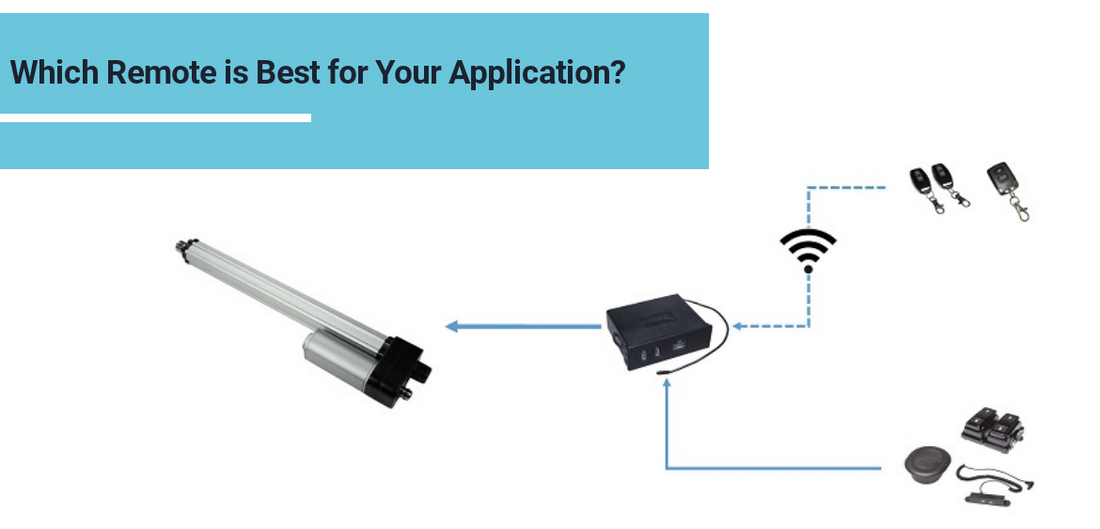A remote controlled linear actuator enables the actuator stroke length to be positioned and controlled through the use of a remote device, acting as the user interface of the linear actuator. The remote provides a convenient way to send signals to the actuator for it to extend, retract, or stop. It’s particularly useful in applications where the actuator is located at height or distance from where it is to be controlled. Depending on the type of remote control for a linear actuator, they will give you the advantage of the accessibility of control, comfortable use of the actuator, and an efficient way to manage the actuator positioning without the physical use of a nearby switch.
The choice of a linear actuator remote depends on the type of application for its use and your preferences. While in some applications, the choice is obvious, in others, more than one remote type can be used or one remote type can function in more than one application. To help you make this choice a bit easier, we will discuss how linear actuator remotes work, the various types, and offer some tips on what to consider while choosing linear actuator remotes.
How does a Remote Control for a Linear Actuator Work?
The remotes are simple electrical devices that pass signals to a control box. A control box is a device that translates radio frequency and digital on/off signals to extend, stop, and retract the linear actuator. The remote, together with the control box, make up the linear actuator remote control system. The remote is activated by a user with the press of a button or the turn of a switch. Depending on the setting in the control box, the remote control can be operated momentarily, where the signal is continuously sent while the button is held, or non-momentarily, where each button press extends/retracts or stops the linear actuator.

Types of Linear Actuator Remotes
There are different types and categories of remote controls for a linear actuator. The choice of a remote depends on what is considered best suited for the actuator application. Regardless of the type, our remotes can be single channel or with multiple channels for the control of more than one linear actuator and additional programming functions.
Linear Actuator Remotes can be Wireless or Wired
A linear actuator with a wireless remote control uses radio frequency to send signals to a control box. Wireless remotes can operate 30-50 feet away (open-air) and without a line of sight. They are best used in applications where there is a distance between the linear actuator and the control point and it is not possible or convenient to have a wired connection.
Wired remotes, on the other hand, have a physical cable connection to the control box. They perform the same function as the wireless remotes and are best suited for applications where the control point is close to the linear actuator. Wired remotes offer extra robustness with a physical connection to the actuator but lack the mobility of a wireless remote. For wired remotes, it is important to check the voltage ratings. It is quite typical to use a 12v linear actuator remote control where 12 VDC is supplied across the control box and to the linear actuator.

Linear Actuator Remotes can be Handheld, Foot Pedaled or Mounted
Handheld remotes are mobile remotes that can be carried on you like a bunch of keys; convenient and offer mobile flexibility of use! They’re particularly useful in applications where the user is required to have different control viewpoints of the linear actuator.

Foot pedaled remotes can be quite essential, particularly in applications where you simultaneously have to use your hands for other functions. It can also be used where the feet provide the easiest point of control. By using the foot as a control point, foot pedaled remotes expand the possibilities for how the linear actuator is controlled.

Mounted remotes are best suited for applications where the actuator is close to the control point or needs to be directly attached in a fixed position, for example, a table or a wall. This remote is often used in furniture and home applications.
Selecting the Best Linear Actuator Remote for Your Application
Since the choice of a linear actuator remote depends on the specific application it will be used for and the preference of the user, several remote types can be suited for a single application. There are many factors to consider that can serve as a guide in the selection:
Mobility
If there is intent to have a remote that has a single user with a desire to have control wherever the user is, even without a line of sight to the linear actuator, then wireless hand remotes are a good choice. They are popularly used in applications such as valve operation, solar panel positioning, satellite dish positioning, hatch opening in greenhouses, and truck lift gates.
Hands-free
When you intend to have free hands for other simultaneous functions while having full control of the linear actuator, the foot pedaled remotes becomes the obvious choice. Applications such as workbenches, moveable platforms, scissor lifts, electric pallet trucks, hospital beds, computer workstations fit well with foot pedaled remotes as you will have your hands for other activities such as tool work, picking tomatoes and steering vehicles.
Proximity
Mounted remotes are an excellent choice if the linear actuator needs to be within the visible distance of the remote and would potentially be used by more than one person. For example, a mounted remote will be the right choice for a height-adjustable office desk, recliners, lift chairs like massage chairs, salon chairs, dentist chairs, worktops, and kitchen furniture. The remote set the most comfortable and ergonomic posture while you experience directly the impact of the control.
Conclusion
Remote controlled linear actuators give the user the flexibility to control the linear actuator comfortably and conveniently. The connections to the linear actuator through the control box are simple and easy to configure for both wireless and wired remote control. There are various types of linear actuator remotes for different applications and user preferences – by understanding the purpose of the linear actuator and how you desire it to be controlled, the best remote control type for the application can be selected.




